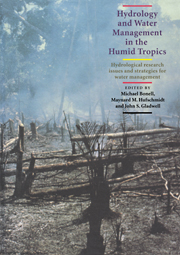 Hydrology and Water Management in the Humid Tropics
Hydrology and Water Management in the Humid Tropics Published online by Cambridge University Press: 23 December 2009
ABSTRACT
The hydrological processes in Amazonia vary widely from year to year due to natural changes in the atmospheric conditions. This paper reviews the dynamic mechanisms that produce rainfall in the region, its characteristics and fluctuations due to inter-annual variability of the large-scale atmospheric circulations associated with the El Niño-Southern Oscillation phenomenon (ENSO) and blocking patterns of the atmospheric flow. It is hypothesized that the observed trends in precipitation, as well as runoff, reported by Rocha et al., (1989), may be related to a higher frequency of positive phases of ENSO and/or the presence of volcanic aerosols in the stratosphere over Amazonia. Such aerosols could influence the heating of the Andean Altiplano and, in turn, the seasonal development of the upper tropospheric anticyclone over tropical South America (Bolivian High). The effects of large-scale deforestation on local hydrology as well as the possible impacts on global climate are also discussed.
INTRODUCTION
The hydrologic cycle is an integrated product of the climate and of the biogeophysical attributes of the surface. On the other hand, it exerts an influence on climate which goes beyond the interaction between the atmospheric moisture, rainfall and runoff. It is the major single heat source for the atmosphere, in the form of latent heat which is released, mainly in the tropics, through the condensation of atmospheric moisture into clouds and rainfall.
Attempts to identify patterns in climatic fluctuations are mostly inconclusive because the climate, hence the hydrologic cycle, presents an intrinsic variability, both in space and time, which is not adequately known.
To save this book to your Kindle, first ensure [email protected] is added to your Approved Personal Document E-mail List under your Personal Document Settings on the Manage Your Content and Devices page of your Amazon account. Then enter the ‘name’ part of your Kindle email address below. Find out more about saving to your Kindle.
Note you can select to save to either the @free.kindle.com or @kindle.com variations. ‘@free.kindle.com’ emails are free but can only be saved to your device when it is connected to wi-fi. ‘@kindle.com’ emails can be delivered even when you are not connected to wi-fi, but note that service fees apply.
Find out more about the Kindle Personal Document Service.
To save content items to your account, please confirm that you agree to abide by our usage policies. If this is the first time you use this feature, you will be asked to authorise Cambridge Core to connect with your account. Find out more about saving content to Dropbox.
To save content items to your account, please confirm that you agree to abide by our usage policies. If this is the first time you use this feature, you will be asked to authorise Cambridge Core to connect with your account. Find out more about saving content to Google Drive.